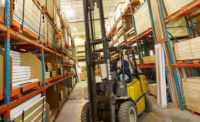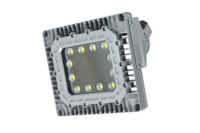Safety and reliability are of the utmost importance when illuminating a work area, sporting complex, roadway, or any populated area. Power outages, mechanical or equipment failure, or acts of nature can introduce hazards into the environment. Without proper illumination, risk for accidents and injury is increased. Advances in LED technology have solutions that address these safety issues.
Power outages
Traditional metal halide fixtures have warm up and cool down periods, the latter often referred to as a “restrike time,” with durations as long as 45 minutes between shutting the fixture off and the fixture reaching full illumination. The ballasts are programmed to warm up slowly to prolong the life of the ballast, and will not instantly turn the lamp back on at the flip of a switch.
Should this occur due to a power outage, power surge, or brown out, a significant risk can exist while waiting for the light fixtures to restrike. Workers are left without a main source of lighting to operate heavy machinery and equipment.
With LED light fixtures, there is no warm up or cool down time. LED light fixtures are instantly on, providing instant illumination when lighting is needed. If a power outage occurs or power is cut to the light fixtures, the lights will resume illumination as soon as power is supplied to them. This reduces risks while waiting in the dark for ballast style fixtures to warm up, and eliminates down time associated with warm up times.
Maintenance
1000 watt metal halide lamps have an average lamp life span of 10,000 to 12,000 hours, barring any irregular conditions that shorten this lifespan. How long the lamp will continue to operate and how long the lamp will produce enough illumination operate with are two different things.
This is referred to as lamp lumen depreciation. Not all lamps will survive to the rated lamp life. Vibration, impacts, weather, power surges, faulty ballasts, and acts of nature can lead to premature failure. Ballasts and other internal components have rated lives as well, and will expire over time.
To save on maintenance costs, re-lamping is typically done in groups after a number of fixtures have reached a point where the lamps or other components are no longer operational. Low lighting conditions can introduce shadows and blind spots, creating a hazard and potential for accidents.
Many of these fixtures are in high locations, requiring special equipment for maintenance. This routine maintenance introduces its own risks: accessing fixtures and working on them while in the air with special lift equipment, or having to bring the fixture to ground level.
LED fixtures have dramatically longer lamp lives when compared to metal halide fixtures. Instead of an average life span of 10,000 to 12,000 hours, LED fixtures have expected lamp lives up to 100,000 hours with 70-80 percent lumen retention at the 100,000 mark. Re-lamping required for optimal illumination is significantly reduced.
LED fixtures are not susceptible to humidity, impacts, vibrations, and drastic temperature changes that plague metal halide fixtures and will lead to premature failure of metal halide lamps. Many LED fixtures are fitted with multiple LED banks and multiple LED drivers -- added fail safes to the LED design. For a metal halide fixture, when the lamp or the ballast fails, the lamp will cease operation. In LED fixtures with multiple LED banks, a failed LED bank will cease operation while the remaining LED banks will continue to function as normal. In LED fixtures with multiple LED drivers, should one LED driver fail, only half of the fixture will cease operation while the remaining half of the fixture will continue to function as normal.
Fixtures on the market offer both these fail-safe precautions for added protection and reduced maintenance. This reduced the costs to repair and maintain the fixtures, and the risks associated with maintaining the fixtures are also reduced. Overall performance and reliability is increased by providing a more stable and reliable light source.
Best practices
When comparing metal halide to LED, everyone is aware of energy savings. But there is more to consider.
Metal halide lamps are omni-directional, and beam distribution is controlled with a single reflector positioned around the lamp. LEDs are directional, and the beam distribution is controlled with optics in front of the multiple LEDs in a single fixture, or multiple reflectors around multiple LEDs in a single fixture.
The higher the light fixture is mounted, the more narrow the beam spread configuration must be to reach the optimum beam spread at the work field plane. Too narrow of a configuration will create hot spots in some areas while not providing enough light in others. Too wide and there will not be adequate illumination at the work field plane.
Improper positioning of the light heads may induce glare and light pollution.
It’s important to work with an engineering firm or lighting manufacturer to help design future projects and assist with retrofitting existing fixtures with LEDs fixtures. With the use of sophisticated lighting software, such as AGi32, lighting designers can calculate the illumination levels from existing light fixtures. From there, they can develop a design to retrofit existing light fixtures with LED fixtures to provide increased safety and reliability, without sacrificing light quality or light performance. If desired, light performance can be increased.
For new projects, lighting designers can model the entire project and provide 3D renderings of what the project will look like, as well as export CAD models to aid engineers in the design process.
By swapping to LED fixtures instead of metal halide, safety, reliability, and productivity significantly increase and maintenance and energy consumption is decreased. Metal halides have warm up and cool down times; LEDs are instant on illumination. Metal halides have a short lamp life and multiple components that can fail; LED fixtures have expected lamp lives that are five to ten times that of metal halide and can be offered in configurations with multiple fail-safes to remain operational.



